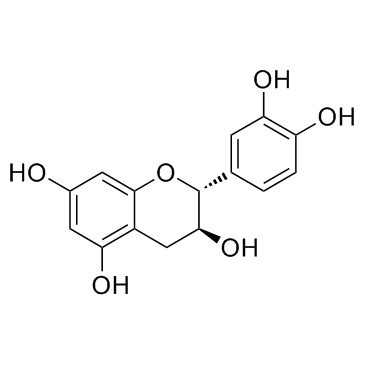Catechin ((+)-Catechin) |
| カタログ番号GC32841 |
カテキン ((+)-カテキン) ((+)-カテキン ((+)-カテキン)) は、1.4 μ の IC50 でシクロオキシゲナーゼ-1 (COX-1) を阻害します;M.
Products are for research use only. Not for human use. We do not sell to patients.

Cas No.: 154-23-4
Sample solution is provided at 25 µL, 10mM.
Catechin inhibits cyclooxygenase-1 (COX-1) with an IC50 of 1.4 μM.
Catechin exhibits >95% inhibitory activity at 70 μg/mL against cyclooxygenase-1 (COX-1) with an IC50 of 1.4 μM[1]. A dose-dependent reduction in color is observed after 24 hours of treatment with Catechin, and 54.76% of the cells are dead at the highest concentration of Catechin tested (160 μg/mL) whereas the IC50 of Catechin is achieved at 127.62 μg/mL Catechin. A dose- and time-dependent increase in the induction of apoptosis is observed when MCF-7 cells are treated with Catechin. When compare to the control cells at 24 hours, 40.7 and 41.16% of the cells treated with 150 μg/mL and 300 μg/mL Catechin, respectively, undergo apoptosis. The expression levels of Caspase-3, -8, and -9 and p53 in MCF-7 cells treated with 150 μg/mL Catechin for 24 h increase by 5.81, 1.42, 3.29, and 2.68 fold, respectively, as compare to the levels in untreated control cells[2].
Animals treated with Catechin at the lowest tested dose, i.e., 50 mg/kg, p.o. have spent comparatively more time in exploring the novel object in the choice trial, however, the difference is not statistically significant. Catechin prevents the time-induced episodic memory deficits in a dose-dependent manner, the most effective being 200 mg/kg, p.o.. Treatment with Catechin prevents the rise in MPO level compare to DOX alone treatment group (21.98±9.44 and 36.76±4.39% in the hippocampus and the frontal cortex respectively)[3].
[1]. Waffo-Téguo P, et al. Potential cancer-chemopreventive activities of wine stilbenoids and flavans extracted from grape (Vitis vinifera) cell cultures. Nutr Cancer. 2001;40(2):173-9. [2]. Alshatwi AA. Catechin hydrate suppresses MCF-7 proliferation through TP53/Caspase-mediated apoptosis. J Exp Clin Cancer Res. 2010 Dec 17;29:167. [3]. Cheruku SP, et al. Catechin ameliorates doxorubicin-induced neuronal cytotoxicity in in vitro and episodic memory deficit in in vivo in Wistar rats. Cytotechnology. 2018 Feb;70(1):245-259.
Average Rating: 5 (Based on Reviews and 34 reference(s) in Google Scholar.)
GLPBIO products are for RESEARCH USE ONLY. Please make sure your review or question is research based.
Required fields are marked with *




















